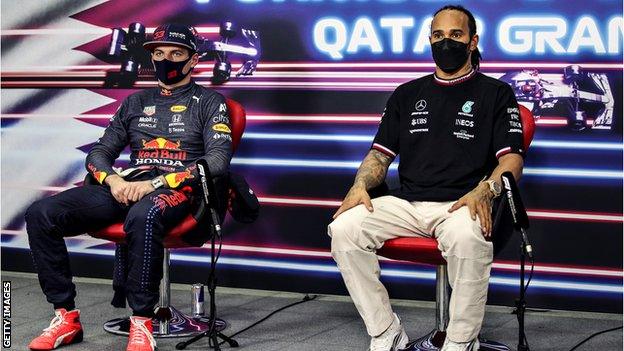Qatar Grand Prix: Fair racing debate rages on between Hamilton and Verstappen
- Published

The Qatar Grand Prix is live on 5 Live and the BBC Sport website
Title rivals Max Verstappen and Lewis Hamilton continue to be at loggerheads over driving standards as they head into the decisive final three grands prix of the season.
After taking an outstanding pole position for Sunday's Qatar Grand Prix, Hamilton said it was still "not clear" as to what is and is not acceptable when racing for position following the row over Verstappen's driving in Brazil last weekend.
Yet Verstappen insisted that, after a drivers' briefing with race director Michael Masi on Friday evening that lasted more than an hour, "at the end, it was pretty clear".
The other drivers who spoke on the topic pretty much all agreed with Hamilton.
Their comments came as they sat next to each other in the post-qualifying news conference, and during a weekend over which relations between their respective teams have reached a new low.
After qualifying, it is advantage Mercedes in terms of on-track performance. Hamilton was nearly half a second faster than Verstappen's Red Bull, with the Briton's team-mate Valtteri Bottas third on the grid.
On paper, that gives Mercedes the upper hand going into the race. With two cars against one, they should be able to work the race strategy to pincer Verstappen, whose team-mate Sergio Perez could manage only 11th on the grid.
It is less clear who is winning the off-track war of words, although it is certainly clear that Red Bull are making more noise than Mercedes.

Verstappen was trying to defend from a charging Hamilton in Sao Paulo
The dispute over racing ethics
The weekend has been dominated by the fall-out from the incident between Verstappen and Hamilton on lap 48 of last weekend's Sao Paulo Grand Prix, when the Red Bull driver escaped even an investigation from race stewards for apparently forcing Hamilton off the track as the Mercedes driver tried to overtake around the outside of Turn Four.
During the week, Mercedes requested a review of that decision, which was rejected on Friday on the basis that the new evidence submitted did not substantially add any information to that which was already available at the time.
The problem is that it has left the drivers in a quandary as to what they can get away with while racing.
Most have been reluctant to talk about it publicly, but both Charles Leclerc of Ferrari and McLaren's Daniel Ricciardo suggested at the start of the weekend that this had been a shifting of what they understood to be acceptable racing.
Leclerc said he thought the decision meant "overtaking on the outside is going to be very difficult". Ricciardo added that: "You could say it was too hard because both went off the track, neither made the corner."
After qualifying, Hamilton and Verstappen were asked whether the animated discussion in the drivers' briefing had come to a conclusion as to what was hard and fair racing.
Verstappen said: "It is always trying to align everyone in having the same process. Everyone is different and has their own way of racing and defending and overtaking, and it's very hard for the FIA to get everyone on the same line. They decide but every driver has a different opinion.
"Yesterday it was all about sharing their opinions and the FIA explaining their process of thought behind it. We came a long way. It was a very long briefing. I think at the end it was pretty clear."
"No," Hamilton said. "It's not clear. Every driver except for Max - most drivers - was asking for clarity but it wasn't very clear. It's still not clear what the limits of the track are.
"It's clearly not the white line anymore when overtaking. So we just go for it. We just asked for consistency. If it's the same as the last race, it should be the same for all of us in those scenarios and that's fine."
Muddying the waters still further, Hamilton said that in the meeting the representatives of the governing body had made it clear that a different set of officials might make different decisions.
"They said it could be different with different stewards," he said, "but we have the same ones as last week this week."
It's hard to get a complete sense of where all the drivers are, because many are reluctant to speak about such controversial topics, not least because what happens in the drivers' briefing is meant to be confidential.
But on Saturday, Williams driver George Russell, McLaren's Lando Norris and Ricciardo and Ferrari's Carlos Sainz more or less agreed with Hamilton.
Russell - who is a director of the Grand Prix Drivers' Association, and will be Hamilton's team-mate at Mercedes next year - said: "Unfortunately, there was no outcome.
"I do appreciate you need to judge every single case [on its merits] but for me that was not even close to the line of what went on [in Brazil], it was well beyond the line. And if that had been the last lap of the race, in my opinion it would have been a slam-dunk penalty for Max."
Russell also said he questioned Masi's claim that all incidents are judged on their merits and with no consideration of the context or consequences.
"I think Max wasn't punished purely because Lewis won the race," he said, "but the consequences shouldn't be a factor in the punishment. You should judge the incident on a race-by-race basis. That's what they've always told us - it's not the consequences, it's the incident.
"We all want to race hard but that was hard and unfair and we want hard and fair racing."
Sainz said: "I agree with George. It looks like over the winter there will be some big conversations about how we go racing as a sport. If the car on the inside should leave space on the outside in any case or not.
"We need to rethink the whole approach because, the way it's been working, it's pretty clear that the drivers don't fully understand what is going to happen depending on what you do."
Verstappen and his team boss Christian Horner felt that what happened in Brazil was "hard and fair racing". Many others do not. Mostly, the drivers just want to know what's allowed and what's not.
It leaves both Hamilton and Verstappen in an invidious position heading into their championship showdown - especially given that Verstappen, with a 14-point advantage, has less to lose from contact than Hamilton.
Mercedes F1 boss Toto Wolff said: "It's very dangerous because what happened yesterday and also in Brazil is kicking the ball in the high grass and hoping it disappears.
"But if we were to have a controversial situation in any of the three races that are to come, can you imagine the polarisation and controversy it would create simply because it wasn't clearly formulated?
"Even if the outcome was negative for us in Brazil in terms of the immediate judgement, I would have taken that if the consequent analysis would have been that's not on. Because I think that would have been easier for everybody for the next races."

Red Bull had trouble stopping their rear wing from moving in practice
The dispute over car legality
Off track, it has been another bad-tempered and fractious weekend between Mercedes and Red Bull, whose relationship was summed up nicely by Wolff when he said: "What started as Olympic boxing went to pro boxing and is now MMA, but that's OK.
"We are in the ring trying to do the best job possible, elbows are allowed now because the rules say so and gloves are off and nothing else is to be expected."
Horner has spent the weekend casting aspersions on Mercedes' rear wing, claiming they had found a way for part of it to flex illegally on the straights to give them an advantage and that this explained their upturn in performance in Brazil, when Hamilton made up a total of 25 places over a sprint race and a grand prix to win from the back.
"Would I protest? Absolutely," Horner said. "If we believe that the car is not in compliance we will protest, because the straight-line speeds we have seen in Mexico and Brazil… I think everybody could see in Brazil it was not a normal situation.
"Yes, we know with Mercedes a new engine comes with increased performance but when you have a 27 km/h closing speed and you see 'witness' marks on rear wing end-plates that have been marking up from wings that have been flexing, it's very clear to us what has been going on.
"It's down to the FIA but if we feel that to make sure the cars are in compliance you protest if you believe a competitor isn't complying with the rules."
Wolff rejected Horner's claims about marks on the wing, saying Red Bull were "seeing ghosts".
After qualifying, Horner was mollified somewhat when he saw that Hamilton's advantage over Verstappen in the speed traps was less than it had been in Brazil - 3.4km/h compared to 9.2km/h.
He described Mercedes' straight-line speed as "under control", adding: "It looks very similar to our straight-line speed now, which is good to see. Lewis made all his time in Turns Six and Seven, particularly on that last lap. He had an amazing sector through that sequence of the two slower corners."
But there was one key difference - Hamilton was not using the brand new engine that had been fitted in Brazil at the expense of a grid penalty.
In Saudi Arabia in two weeks' time, though, he almost certainly will be. On a track that looks as if it has many high-speed sections. So what happens then?
